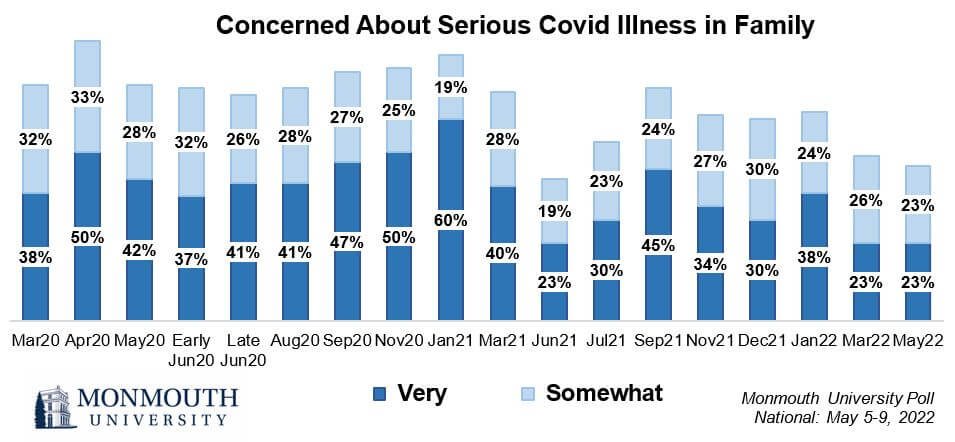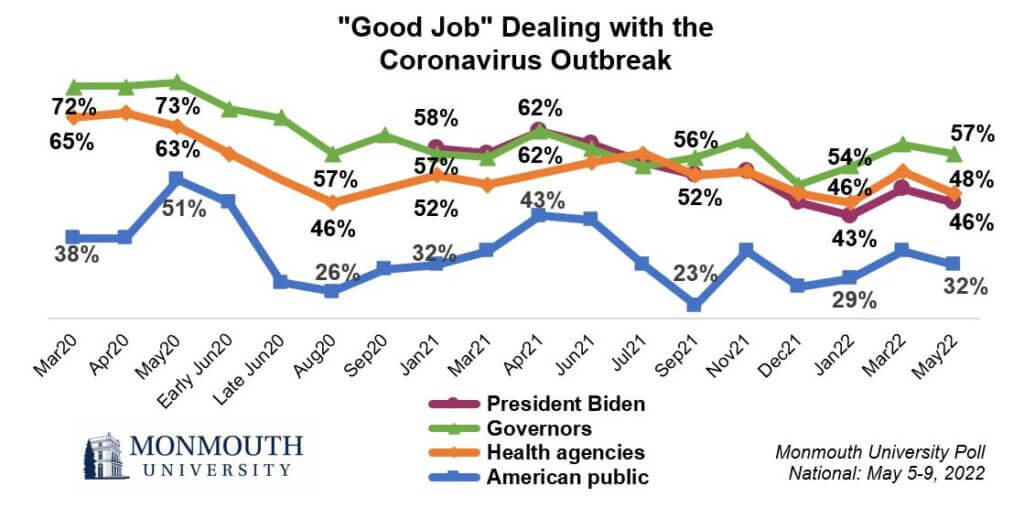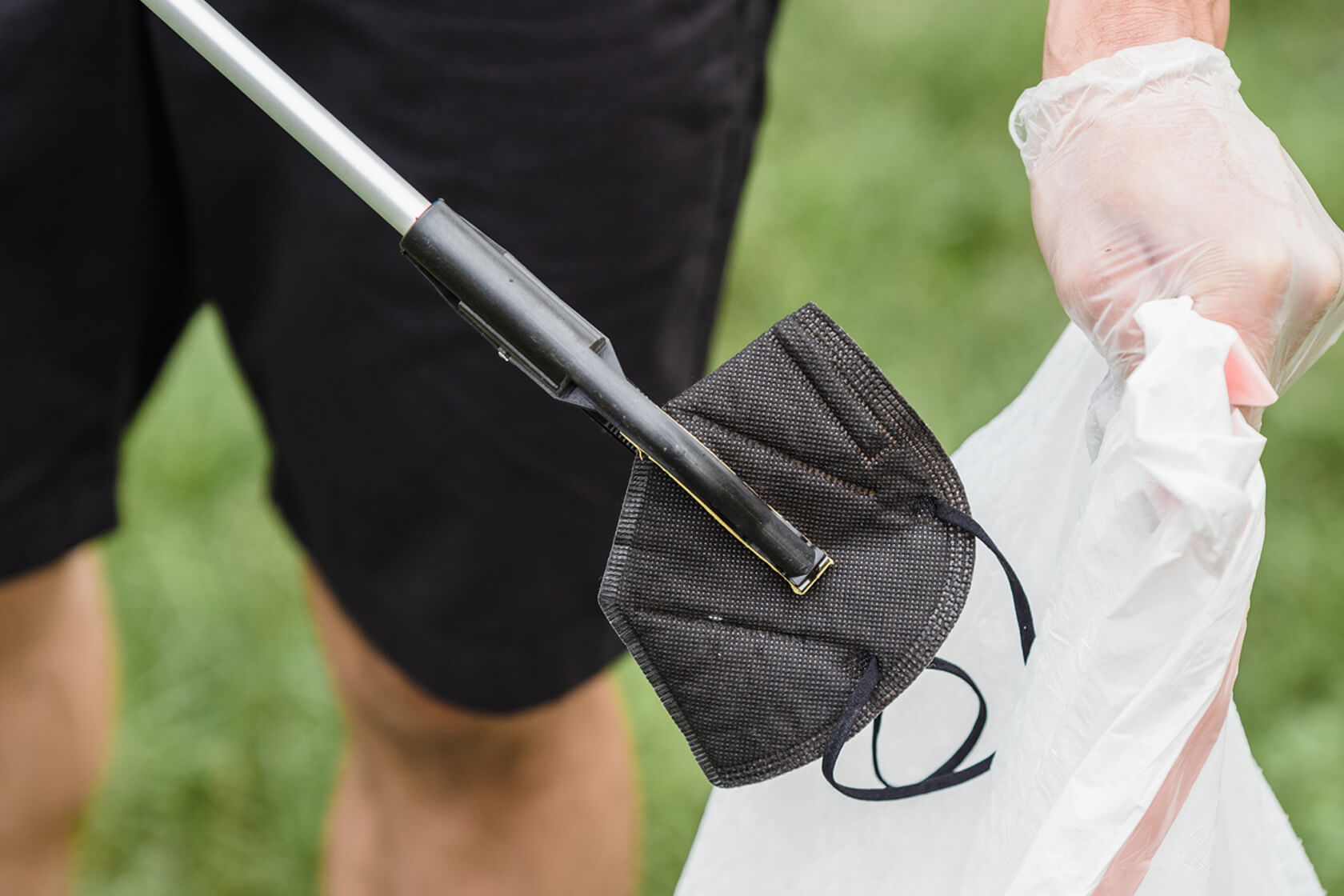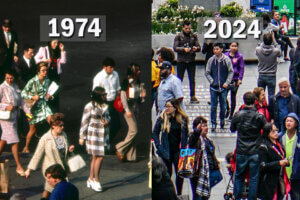West Long Branch, NJ –The latest Monmouth (“Mon-muth”) University Poll finds that concern about family members becoming ill from the coronavirus remains relatively low and is approaching the nadir it hit briefly last summer. This comes as reports of COVID-19 infections are leveling off. Only one-third of the public supports a return to face mask and social distancing guidelines and about 4 in 10 backs workplace vaccine mandates.
The number of people who are very concerned about a family member becoming seriously ill from the virus remains steady at 23%, the same as in March. This number was 38% in January and hit a pandemic high of 60% one year before that. The current number of Americans (46%) who are either very or somewhat concerned about a family member falling ill with Covid is approaching the momentary low point for this number recorded last summer (42% in June 2021).

In the current poll, 35% of American adults report having tested positive for Covid. This finding is up from January (27%), but similar to March (38%). Another 13% say they were diagnosed without a test or believe they had the disease at some point during the pandemic.
Vaccine uptake, particularly getting a booster shot, remains static. Currently, just under half (49%) of adults report having received a Covid booster dose while one-third (34%) – including a majority of Republicans – say they are not at all likely to get it.
“Public health experts say that Covid is not in the endemic phase yet, but most Americans appear to be acting as if it is. Vaccine rates have hit a wall but few want to go back to a world of mask mandates,” said Patrick Murray, director of the independent Monmouth University Polling Institute.
Just 32% of the public supports instituting or reinstituting face mask and social distancing guidelines in their state at the current time, which is similar to March (34%), but down significantly from January (52%). At the same time, support for requiring people to show proof of vaccination in order to work in an office setting or around other people has held steady – 42% now, 44% in March, and 43% in January. Large majorities of Democrats continue to back vaccine (78%) and mask (59%) mandates, while not much more than 1 in 3 independents and 1 in 5 Republicans agree.
Ratings for how different groups in the country have been handling the pandemic have ticked down just slightly over the past two months, including for President Joe Biden (46% good job, down from 49% in March), federal health agencies (48%, down from 53%), state governors (57%, down from 59%), and the American public (32%, down from 35%). Compared with January, though, the current results are a few points more positive for all four groups.

The Monmouth University Poll was conducted by telephone from May 5 to 9, 2022 with 807 adults in the United States. The question results in this release have a margin of error of +/- 3.5 percentage points. The poll was conducted by the Monmouth University Polling Institute in West Long Branch, NJ.
QUESTIONS AND RESULTS
(* Some columns may not add to 100% due to rounding.)
[Q1-31 previously released.]
32.How concerned are you about someone in your family becoming seriously ill from the coronavirus outbreak – very concerned, somewhat concerned, not too concerned, or not at all concerned?
| TREND: | May 2022 | March 2022 | Jan. 2022 | Dec. 2021 | Nov. 2021 | Sept. 2021 | July 2021 | June 2021 | March 2021 | Jan. 2021 |
| Very concerned | 23% | 23% | 38% | 30% | 34% | 45% | 30% | 23% | 40% | 60% |
| Somewhat concerned | 23% | 26% | 24% | 30% | 27% | 24% | 23% | 19% | 28% | 19% |
| Not too concerned | 26% | 26% | 19% | 20% | 22% | 17% | 21% | 24% | 14% | 12% |
| Not at all concerned | 28% | 24% | 17% | 19% | 15% | 12% | 24% | 32% | 16% | 7% |
| (VOL) Don’t know | 0% | 0% | 0% | 0% | 1% | 1% | 0% | 1% | 0% | 0% |
| (VOL) Has already happened | 1% | 1% | 1% | 1% | 1% | 1% | 2% | 1% | 2% | 2% |
| (n) | (807) | (809) | (794) | (808) | (811) | (802) | (804) | (810) | (802) | (809) |
| TREND: Continued | Nov. 2020 | Early Sept. 2020 | Aug. 2020 | Late June 2020 | Early June 2020 | May 2020 | April 2020 | March 2020 |
| Very concerned | 50% | 47% | 41% | 41% | 37% | 42% | 50% | 38% |
| Somewhat concerned | 25% | 27% | 28% | 26% | 32% | 28% | 33% | 32% |
| Not too concerned | 13% | 13% | 18% | 17% | 14% | 14% | 9% | 18% |
| Not at all concerned | 10% | 12% | 13% | 15% | 16% | 16% | 7% | 12% |
| (VOL) Don’t know | 0% | 0% | 0% | 0% | 0% | 0% | 0% | 0% |
| (VOL) Has already happened | 1% | 0% | 1% | 1% | 0% | 0% | 0% | n/a |
| (n) | (810) | (867) | (868) | (867) | (807) | (808) | (857) | (851) |
33.At any time during the pandemic, did you ever have Covid or think you had Covid? [If YES: Was your Covid status confirmed with a test, were you given the diagnosis by a medical professional without a test, or did you just know you had Covid?]
| TREND: | May 2022 | March 2022 | Jan. 2022 |
| Yes, confirmed with a test | 35% | 38% | 27% |
| Yes, given the diagnosis without a test | 2% | 4% | 2% |
| Yes, just knew had Covid | 11% | 10% | 11% |
| No, have not had Covid | 49% | 47% | 59% |
| (VOL) Don’t know | 2% | 2% | 1% |
| (n) | (807) | (809) | (794) |
34.Please tell me if each of the following has done a good job or bad job dealing with the coronavirus outbreak. [ITEMS WERE ROTATED]
| TREND: | Good Job | Bad Job | (VOL) Mixed, depends | (VOL) Don’t know | (n) | |||
| President Biden | 46% | 50% | 2% | 2% | (807) | |||
| — March 2022 | 49% | 47% | 2% | 2% | (809) | |||
| — January 2022 | 43% | 53% | 3% | 1% | (794) | |||
| — December 2021 | 46% | 46% | 4% | 4% | (808) | |||
| — November 2021 | 53% | 41% | 2% | 3% | (811) | |||
| — September 2021 | 52% | 43% | 4% | 1% | (802) | |||
| — July 2021 | 55% | 38% | 4% | 3% | (804) | |||
| — June 2021 | 59% | 32% | 4% | 5% | (810) | |||
| — April 2021 | 62% | 31% | 3% | 3% | (800) | |||
| — March 2021 | 57% | 31% | 3% | 8% | (802) | |||
| — January 2021 | 58% | 23% | 5% | 15% | (809) | |||
| Your state’s governor | 57% | 39% | 2% | 1% | (807) | |||
| — March 2022 | 59% | 36% | 3% | 3% | (809) | |||
| — January 2022 | 54% | 41% | 3% | 2% | (794) | |||
| — December 2021 | 50% | 41% | 5% | 3% | (808) | |||
| — November 2021 | 60% | 35% | 3% | 3% | (811) | |||
| — September 2021 | 56% | 38% | 3% | 3% | (802) | |||
| — July 2021 | 54% | 42% | 3% | 2% | (804) | |||
| — June 2021 | 58% | 33% | 5% | 4% | (810) | |||
| — April 2021 | 62% | 34% | 3% | 2% | (800) | |||
| — March 2021 | 56% | 38% | 3% | 2% | (802) | |||
| — January 2021 | 57% | 38% | 3% | 2% | (809) | |||
| — Early September 2020 | 61% | 35% | 3% | 1% | (867) | |||
| — August 2020 | 57% | 35% | 5% | 3% | (868) | |||
| — Late June 2020 | 65% | 28% | 5% | 2% | (867) | |||
| — Early June 2020 | 67% | 28% | 3% | 1% | (807) | |||
| — May 2020 | 73% | 22% | 3% | 2% | (808) | |||
| — April 2020 | 72% | 21% | 4% | 3% | (857) | |||
| — March 2020 | 72% | 18% | 4% | 6% | (851) | |||
| The American public | 32% | 59% | 7% | 2% | (807) | |||
| — March 2022 | 35% | 54% | 8% | 2% | (809) | |||
| — January 2022 | 29% | 58% | 9% | 3% | (794) | |||
| — December 2021 | 27% | 56% | 12% | 5% | (808) | |||
| — November 2021 | 35% | 55% | 7% | 3% | (811) | |||
| — September 2021 | 23% | 65% | 10% | 2% | (802) | |||
| — July 2021 | 32% | 51% | 12% | 5% | (804) | |||
| — June 2021 | 42% | 40% | 14% | 4% | (810) | |||
| — April 2021 | 43% | 44% | 10% | 4% | (800) | |||
| — March 2021 | 35% | 53% | 11% | 1% | (802) | |||
| — January 2021 | 32% | 60% | 6% | 2% | (809) | |||
| — Early September 2020 | 31% | 57% | 10% | 2% | (867) | |||
| — August 2020 | 26% | 62% | 11% | 1% | (868) | |||
| — Late June 2020 | 28% | 59% | 11% | 3% | (867) | |||
| — Early June 2020 | 46% | 43% | 8% | 2% | (807) | |||
| — May 2020 | 51% | 33% | 13% | 2% | (808) | |||
| — April 2020 | 38% | 48% | 12% | 2% | (857) | |||
| — March 2020 | 38% | 45% | 14% | 3% | (851) | |||
| Health agencies in the federal government | 48% | 46% | 4% | 2% | (807) | |||
| — March 2022 | 53% | 41% | 4% | 2% | (809) | |||
| — January 2022 | 46% | 47% | 5% | 2% | (794) | |||
| — December 2021 | 48% | 41% | 6% | 5% | (808) | |||
| — November 2021 | 53% | 38% | 5% | 4% | (811) | |||
| — September 2021 | 52% | 38% | 6% | 3% | (802) | |||
| — July 2021 | 57% | 33% | 7% | 3% | (804) | |||
| — June 2021 | 55% | 33% | 6% | 5% | (810) | |||
| — April 2021 | n/a | n/a | n/a | n/a | n/a | |||
| — March 2021 | 50% | 37% | 8% | 5% | (802) | |||
| — January 2021 | 52% | 40% | 6% | 3% | (809) | |||
| — Early September 2020 | n/a | n/a | n/a | n/a | n/a | |||
| — August 2020 | 46% | 43% | 6% | 4% | (868) | |||
| — Late June 2020 | n/a | n/a | n/a | n/a | n/a | |||
| — Early June 2020 | 57% | 34% | 5% | 3% | (807) | |||
| — May 2020 | 63% | 25% | 7% | 4% | (808) | |||
| — April 2020 | 66% | 25% | 4% | 4% | (857) | |||
| — March 2020 | 65% | 24% | 8% | 4% | (851) | |||
35.Do you support or oppose instituting, or reinstituting, face mask and social distancing guidelines in your state at the current time?
| TREND: | May 2022 | March 2022 | Jan. 2022 | Dec. 2021 | Sept. 2021 | July 2021 |
| Support | 32% | 34% | 52% | 55% | 63% | 52% |
| Oppose | 65% | 62% | 45% | 42% | 34% | 46% |
| (VOL) Depends | 3% | 3% | 1% | 2% | 2% | n/a |
| (VOL) Don’t know | 1% | 1% | 2% | 2% | 1% | 2% |
| (n) | (807) | (809) | (794) | (808) | (802) | (804) |
36.Do you support or oppose requiring people to show proof of vaccination in order to go to work in an office or setting where they are around other people?
| TREND: | May 2022 | March 2022 | Jan. 2022 | Dec. 2021 | Nov. 2021 | Sept. 2021 |
| Support | 42% | 44% | 43% | 46% | 51% | 53% |
| Oppose | 56% | 55% | 53% | 50% | 47% | 45% |
| (VOL) Depends | 1% | 1% | 2% | 2% | 2% | 2% |
| (VOL) Don’t know | 1% | 0% | 2% | 2% | 1% | 1% |
| (n) | (807) | (809) | (794) | (808) | (811) | (802) |
37.Have you received at least one dose of Covid vaccine, or not?
| TREND: | May 2022 | March 2022 | Jan. 2022 | Dec. 2021 | Nov. 2021 | Sept. 2021 | July 2021 | June 2021 | April 2021 |
| Yes | 77% | 78% | 77% | 78% | 80% | 75% | 68% | 66% | 51% |
| No | 22% | 21% | 20% | 20% | 18% | 21% | 28% | 33% | 48% |
| (VOL) Don’t know | 1% | 1% | 4% | 2% | 3% | 4% | 4% | 1% | 1% |
| (n) | (807) | (809) | (794) | (808) | (811) | (802) | (804) | (810) | (800) |
38.Have you received a booster shot of the Covid vaccine, or not? [If NOT:] How likely are you to get a booster shot of the vaccine – very likely, somewhat likely, not too likely, or not at all likely?
| TREND: | May 2022 | March 2022 | Jan. 2022 | Dec. 2021 | Nov. 2021 | Sept. 2021 |
| Already received booster | 49% | 48% | 45% | 24% | 10%* | 1%* |
| Very likely | 6% | 8% | 11% | 27% | 41% | 51% |
| Somewhat likely | 6% | 4% | 7% | 13% | 14% | 16% |
| Not too likely | 4% | 5% | 7% | 6% | 8% | 6% |
| Not at all likely ** | 34% | 33% | 30% | 27% | 25% | 26% |
| (VOL) Don’t know | 1% | 1% | 0% | 1% | 2% | 1% |
| (n) | (807) | (809) | (794) | (808) | (811) | (802) |
* September/November 2021 polls did not specifically ask if person already got the booster, but included it as a volunteered response.
** Prior to March 2022, this includes results to a previous question on likelihood of getting any dose of the vaccine.
METHODOLOGY
The Monmouth University Poll was sponsored and conducted by the Monmouth University Polling Institute from May 5 to 9, 2022 with a probability-based national random sample of 807 adults age 18 and older. This includes 284 contacted by a live interviewer on a landline telephone and 523 contacted by a live interviewer on a cell phone, in English. Telephone numbers were selected through a mix of random digit dialing and list-based sampling. Landline respondents were selected with a modified Troldahl-Carter youngest adult household screen. Interviewing services were provided by Braun Research, with sample obtained from Dynata (RDD, n=532), Aristotle (list, n=137) and a panel of prior Monmouth poll participants (n=138). Monmouth is responsible for all aspects of the survey design, data weighting and analysis. The full sample is weighted for region, age, education, gender and race based on US Census information (ACS 2018 one-year survey). For results based on this sample, one can say with 95% confidence that the error attributable to sampling has a maximum margin of plus or minus 3.5 percentage points (unadjusted for sample design). Sampling error can be larger for sub-groups (see table below). In addition to sampling error, one should bear in mind that question wording and practical difficulties in conducting surveys can introduce error or bias into the findings of opinion polls.
DEMOGRAPHICS (weighted) |
| Self-Reported |
| 30% Republican |
| 43% Independent |
| 27% Democrat |
| 49% Male |
| 51% Female |
| 30% 18-34 |
| 32% 35-54 |
| 38% 55+ |
| 63% White |
| 12% Black |
| 17% Hispanic |
| 8% Asian/Other |
| 69% No degree |
| 31% 4 year degree |
Click on pdf file link below for full methodology and crosstabs by key demographic groups.




